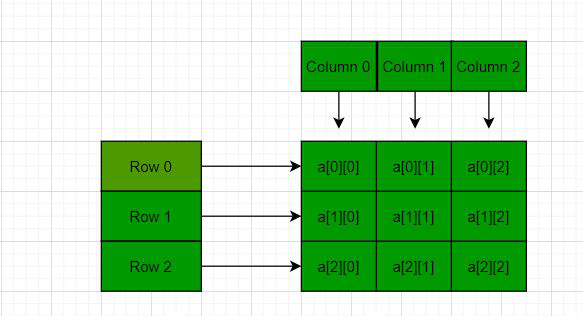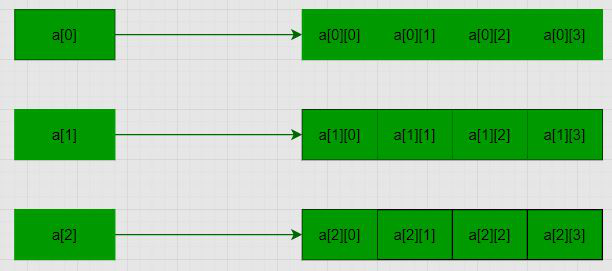如何使用new运算符在C++中动态声明二维数组
在 C/C++ 中,多维数组可以简单理解为数组的数组。多维数组中的数据以表格形式(按行主序)存储。下面是声明 N 维数组的一般形式:
N维数组的语法:
data_type array_name[size1][size2]….[sizeN];
data_type: 要存储在数组中的数据类型。
在这里,data_type 是有效的 C/C++数据类型。
array_name: 数组的名称
size1、size2、…、sizeN: 维度的大小
2D 数组是一维数组的数组。
2D 数组的语法:
data_type array_name[x][y];
data_type: 要存储的数据类型。有效的 C/C++ 数据类型。
下面是二维数组的图示表示:
有关多维数组和 2D 数组的更多详细信息,请参阅C++中的多维数组文章。
问题: 给定一个 2D 数组,任务是在 C++ 中使用 new 动态分配二维数组的内存。
解决方案: 使用以下值声明一个 3 行 4 列的 2D 数组:
1 2 3 4
5 6 7 8
9 10 11 12
注意: 这里 M 是行数, N 是列数。
方法一: 使用单个指针——在此方法中,分配了大小为 M*N 的内存块,然后使用指针算术访问内存块。下面是相应程序:
// C++ program to dynamically allocate
// the memory for 2D array in C++
// using new operator
#include <iostream>
using namespace std;
// Driver Code
int main()
{
// Dimensions of the 2D array
int m = 3, n = 4, c = 0;
// Declare a memory block of
// size m*n
int* arr = new int[m * n];
// Traverse the 2D array
for (int i = 0; i < m; i++) {
for (int j = 0; j < n; j++) {
// Assign values to
// the memory block
*(arr + i * n + j) = ++c;
}
}
// Traverse the 2D array
for (int i = 0; i < m; i++) {
for (int j = 0; j < n; j++) {
// Print values of the
// memory block
cout << *(arr + i * n + j)
<< " ";
}
cout << endl;
}
//Delete the array created
delete[] arr;
return 0;
}
输出:
1 2 3 4
5 6 7 8
9 10 11 12
方法二: 使用指针数组:这里创建了一个指针数组,然后对每个内存块进行操作。下面是说明该概念的图示:
下面是相应的程序:
// C++ program to dynamically allocate
// the memory for 2D array in C++
// using an array of pointers
#include <iostream>
using namespace std;
// Driver Code
int main()
{
// Dimensions of the 2D array
int m = 3, n = 4, c = 0;
// Create an array of pointers
// dynamically
int** arr = new int*[m];
// Traverse through each pointer
for (int i = 0; i < m; i++) {
// Allocate memory of size n with
// each pointer of array
arr[i] = new int[n];
}
// Assign values to allocated memory
for (int i = 0; i < m; i++) {
for (int j = 0; j < n; j++) {
arr[i][j] = ++c;
}
}
// Traverse through the array
for (int i = 0; i < m; i++) {
for (int j = 0; j < n; j++) {
cout << arr[i][j]
<< " ";
}
cout << endl;
}
// Delete the array of pointers
for (int i = 0; i < m; i++) {
delete[] arr[i];
}
delete[] arr;
return 0;
}
输出:
1 2 3 4
5 6 7 8
9 10 11 12
// C++程序:在C++中使用new运算符
// 动态分配二维数组的内存
#include <iostream>
using namespace std;
// 主函数
int main()
{
// 数组的维度
int m = 3, n = 4, c = 0;
// 声明大小为M的内存块
int** a = new int*[m];
for (int i = 0; i < m; i++) {
// 声明大小为n的内存块
a[i] = new int[n];
}
// 遍历二维数组
for (int i = 0; i < m; i++) {
for (int j = 0; j < n; j++) {
// 为创建的内存块赋值
a[i][j] = ++c;
}
}
// 遍历二维数组
for (int i = 0; i < m; i++) {
for (int j = 0; j < n; j++) {
// 输出创建的内存块的值
cout << a[i][j] << " ";
}
cout << endl;
}
// 删除已创建的数组
for (int i = 0; i < m; i++)
// 删除内部数组
delete[] a[i];
delete[] a; // 删除包含所有内部数组指针的外部数组
return 0;
}
输出:
1 2 3 4
5 6 7 8
9 10 11 12
 极客教程
极客教程
